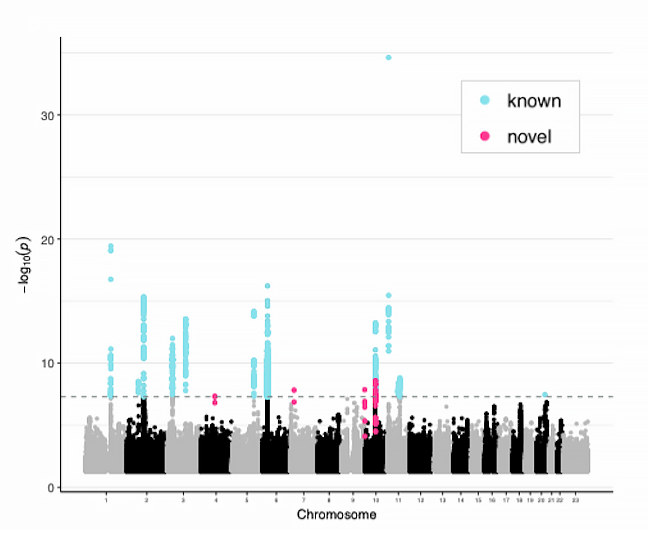Team Leader Chikashi Terao and Graduate Student Research Associate Nao Tanaka of the Laboratory for Statistical and Translational Genetics at the RIKEN Center for Integrative Medical Sciences, along with Team Leader Kazuhiko Yamamoto of the Laboratory for Autoimmune Diseases at RIKEN and others, conducted a large-scale, genome-wide association study (GWAS) of atopic dermatitis in the Japanese population and successfully identified new genetic factors involved in the pathophysiology of the disease.
Atopic dermatitis, an allergic disease, has a high incidence worldwide, and its high heritability suggests that genetic factors are involved in its pathogenesis. The research group conducted a GWAS on 118,287 Biobank Japan (BBJ) registrants, which included 2639 patients with atopic dermatitis and 115,648 control patients.
The analysis identified 17 disease-related regions, including nine regions that were not identified in a previous BBJ GWAS, four of which (AFF1, ITGBB, EHMT1, EGR2) had not been reported by any previous study. The frequency of single nucleotide polymorphisms (SNPs*) in the newly identified disease-related regions was exceedingly low in both European and Japanese populations and was detected as a result of the large scale of the analysis.
Atopic dermatitis was also associated with regions that have been reported in Europeans but not in Asians, including IL13, thereby revealing a common genetic factor related to the disease onset. Additional analysis of genetic polymorphisms (genomic regions that vary among populations) revealed that SMAD4, an important immunity-related transcription factor, is also associated with the disease.

Credit: RIKEN
Team Leader Terao said, "Even though we found several disease-associated regions common to Japanese and European populations, we also identified regions that could be exclusive to the Japanese population. Therefore, these regions represent therapeutic targets for atopic dermatitis in the Japanese population. Moreover, potentially causal polymorphisms in some of the regions have also been identified. We expect that these findings will advance atopic dermatitis onset prediction and clarification of the disease pathophysiology."
■ Single nucleotide polymorphism (SNP)
Genetic polymorphism refers to the existence of two or more alleles within a population at a specific genetic locus.
A single nucleotide polymorphism (SNP) is a type of genetic polymorphism that involves substitution of only one nucleotide.
This article has been translated by JST with permission from The Science News Ltd.(https://sci-news.co.jp/). Unauthorized reproduction of the article and photographs is prohibited.




